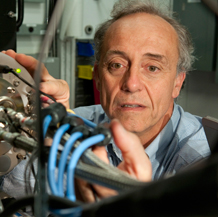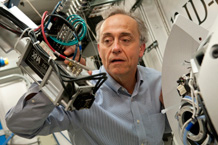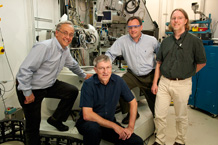Earth science study at Argonne intensifies
The circular Experiment Hall at Argonne National Laboratory's Advanced Photon Source (APS) accelerator is so large that it could encircle Chicago's U.S. Cellular Field. Inside the hall are 35 individual "sectors" with laboratories equipped to tap the x-rays that are emitted by the electrons racing around the ring. Each sector typically has at least two x-ray beamlines on which to conduct experiments.
Nevertheless, this is not enough capacity to meet the needs of scientists from Argonne, the University of Chicago and around the world who want to use APS, which produces the brightest x-ray beams in the Western Hemisphere. After all, scientists in practically every discipline could use these x-ray beams to learn more about their field, be it materials science, biology, chemistry, physics, planetary science or environmental science.
A $766,502 National Science Foundation grant and funds from the U.S. Department of Energy and National Aeronautics and Space Administration are being used to increase the capacity and capabilities of the GeoSoilEnviroCARS (GSECARS) sector. The upgrade will double available beam time and provide new capabilities on GSECARS' undulator beamline. GSECARS is one of the three APS sectors managed by the Center for Advanced Radiation Sources (CARS) at the University of Chicago.
"Argonne already serves more than 5,000 scientists but we want to be able to accommodate -- free of charge -- any scientist with a good idea," says Principal Investigator Mark Rivers, Senior Scientist in Geophysical Sciences and Associate Director of CARS. "Also, we want to continue to be the world's premier facility for research related to earth science."
Intense focus
The x-ray beamlines at APS allow scientists to pursue new knowledge about the structure and function of materials in the center of the Earth, in outer space and at points between. Much of the research is aimed at trying to understand processes that have practical implications, such as how to treat soil that has been contaminated with metals or gasoline, how to stably remove carbon dioxide from power-plant emissions, and how volcanoes and earthquakes work.
"These studies promise to have far-reaching impact on our technology, economy, health and fundamental knowledge of the materials that make up our world," Rivers says. "To name just a few examples, the knowledge gained will help us mitigate man's impact on the environment, improve our understanding of the Earth, and shed light on the origin of the solar system."
The instruments in Rivers' lab are equipped to make many different types measurements. One instrument, for example, makes tiny, intense x-ray beams to measure small amounts of environmental contaminants. Another makes measurements at very high pressure and temperature. Current experiments include studies about:
- The distribution and chemistry of toxic elements such as lead and chromium in soils plants
- The chemistry of comet dust that was brought back to earth by a spacecraft that flew through the comet's tail and
- The structure of materials under the very high pressures and temperatures of deep Earth.
"The facility this new NSF-ARRA funding is helping to improve is vital to the research of hundreds of earth and environmental scientists from around the globe," Rivers says. "It's answering fundamental questions about the core of the earth, the biosphere and the far reaches of the solar system."
by Greg Borzo
This award is funded under the American Recovery and Reinvestment Act of 2009, NSF Award number: 0841622. For more information on NSF's Recovery Act projects, visit NSF Recovery Act.













